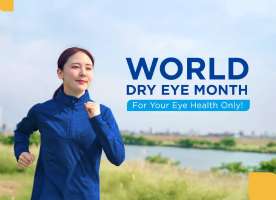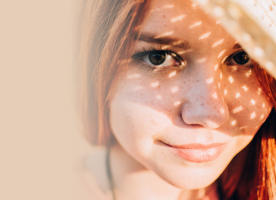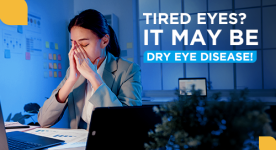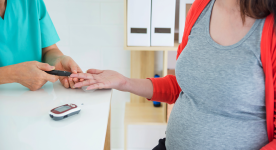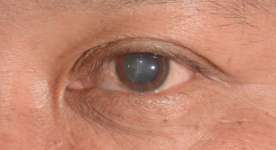Is Depression One Of The Causes Of Dry Eyes Disease?
Depression affects around 280 million people worldwide, equivalent to 3.8 % of the global population; this figure is projected to increase.1 It can reduce school performance, work productivity, relationship quality, and social ability, and disturb all aspects of life in general. A plethora of studies suggested that depression aggravated dry eye symptoms; simultaneously, dry eyes may also make patients more anxious and depressed. Hence, researchers urged ophthalmologists to pay more attention to the potential mental comorbidities when treating Dry Eye Diseases.
Depression
Depression is a common but serious mental disorder, which can affect anyone regardless of age, gender or circumstances. It can lead to a lot of consequences in daily life, substantially impairing one’s ability to function at school or work or handle social and family relations.1,2 In the worst-case scenario, depression can result in suicide, which is the fourth leading cause of death in 15-29-year-olds.1
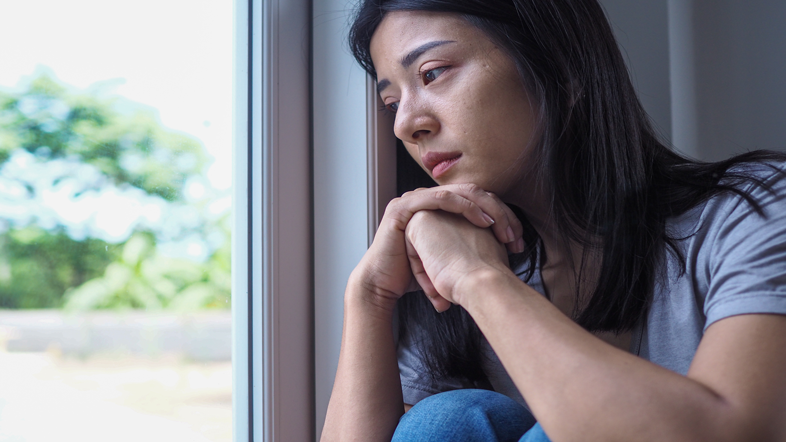
Depression should be distinct from mood fluctuations and short-term feelings of stress or fear that an individual can sometimes experience in their lives. A person diagnosed with depression must suffer from symptoms for at least two weeks.3 The symptoms can vary in terms of severity and duration. These include depressed mood, loss of interest, energy drop, self-worthlessness or inappropriate guilt, sleep disturbance, low concentration, and suicidal thoughts. Recent studies showed that depression might also exacerbate the symptoms of dry eye disease.4,5
Generally, the symptoms are similar in children, teenagers, and adults, but there still exist some differences. Children may suffer from sadness, worries, clinginess, underweight, pains, and refusal to go to school. Teenagers can feel sad, irritable, worthless, misunderstood, and extremely sensitive. Also, they may perform poorly in school, be regularly absent from classes, use recreational drugs or alcohol, eat or sleep extensively, lose interest in normal activities, and avoid social interactions. In adults, depression regularly remains undiagnosed and untreated, and this group of people is often reluctant to seek help. Their symptoms include personality changes and difficulties memorizing, physical aches, fatigue, loss of appetite, sleep disturbance, loss of sex interest, avoidance of social activities, and suicidal thinking.6
Depression can be subdivided into several categories:3
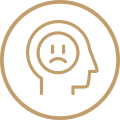 Major depression
Major depression
Symptoms that interfere with working, sleeping, studying, and eating for at least 2 weeks.
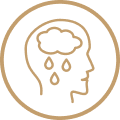 Dysthymia
Dysthymia
Less severe symptoms lasting for at least 2 years.
 Perinatal depression
Perinatal depression
A woman experiences major depression during pregnancy or after giving birth.
 Seasonal affective disorder
Seasonal affective disorder
Accompanied by seasons, normally begins in late fall or early winter and disappears during spring and summer.
 Depression with symptoms of psychosis
Depression with symptoms of psychosis
A severe form in which patients experience delusions and hallucinations.
Causes and risk factors
Depression is an outcome of complex interactions among social, psychological, and biological factors1,7
- Stressful events: unemployment, bereavement, trauma.
- Personality: low self-confidence, being overly self-critical; these traits can be inherited from parents or built up through life experiences.
- Genetics: if a relative has suffered from depression in the past, you are more likely to develop it.
- Giving birth: hormonal and physical changes and added responsibilities may cause perinatal depression.
- Loneliness: cutting off relationships with family or friends can increase the risk of depression.
- Alcohol and drugs: these substances affect the chemistry of the brain, which may lead to depression.
- Medical conditions: chronic illnesses, such as ischemic heart disease, Parkinson’s disease, and diabetes, appear to be risk factors for depression.8 Some studies also demonstrated that dry eye disease is associated with a higher prevalence of this disease.9,10
Depression can worsen Dry Eye Disease (DED)
A lot of scientific papers reported that moderate-to-severe DED patients who had depression had worse DED symptoms4,11,12 and signs4 compared with those who were negative for depression. The mechanisms behind remain unclear, but there are some possible explanations for that:4
- Depression profoundly affects lifestyle habits, including making patients spend more time watching TV and using computers and increasing screen time which puts people at higher risk of DED.13
- People with depression may change their pain sensitization, making them percept the symptoms of DED differently.
- Depression and DED may share underlying inflammatory factors. A study found inflammatory markers in people with depression and DED in comparison with the control group.14 However, a recent study found that there was no significant difference in inflammation markers between DED patients with and without depression.4
- Antidepressants can be a risk factor for DED, as suggested by many studies.15,16 But, there was also a paper that found no association between them.4
Effective treatment of DED is linked to improvement in depression
DED can lead to a considerable psychological burden.9 It can be explained by the fact that DED may irritate and disturb daily activities, thereby potentially lowering the quality of life and raising the risk of depression4. Relief of DED with effective treatment could improve the symptoms of depression and anxiety.9
Prevention and treatment of depression
Based on strong mutual relationships between dry eyes and depression, researchers recommended doctor to screen for psychological problems in patients with moderate to severe DED. This may help patients avoid the serious consequences of both diseases. In addition, depression is diagnosable, treatable, and preventable in some cases. Hence, it is better to take action against the disease:
 Keep yourself healthy
Keep yourself healthy
Exercise regularly, sleep enough, and do not isolate yourself, spend time with people you love and care about.
 Seek help
Seek help
If you have problems and feel stuck, seek counselling or psychotherapy.
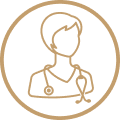 Medication or therapy
Medication or therapy
Talk to your doctor to determine the suitable medication or therapy. If you have mild depression, alternative medicine such as massage, acupuncture, and hypnosis may help improve your well-being. In other cases, you may need to take antidepressants to help you with your condition. Another treatment is brain stimulation therapy, which can be helpful for those who have severe depression.

- Depression. https://www.who.int/news-room/fact-sheets/detail/depression (accessed 2022-09-27).
- World Health Organization. Depression and Other Common Mental Disorders: Global Health Estimates; WHO/MSD/MER/2017.2; World Health Organization, 2017.
- Depression. National Institute of Mental Health (NIMH). https://www.nimh.nih.gov/health/topics/depression (accessed 2022-09-27).
- Zhou, Y.; Murrough, J.; Yu, Y.; Roy, N.; Sayegh, R.; Asbell, P.; Maguire, M. G.; Ying, G.; DREAM Study Research Group. Association Between Depression and Severity of Dry Eye Symptoms, Signs, and Inflammatory Markers in the DREAM Study. JAMA Ophthalmol. 2022, 140 (4), 392. https://doi.org/10.1001/jamaophthalmol.2022.0140.
- Nepp, J. Depression as Ophthalmologic Problem in Dry Eye Syndromes. Invest. Ophthalmol. Vis. Sci. 2014, 55 (13), 1480.
- Depression (major depressive disorder) - Symptoms and causes. Mayo Clinic. https://www.mayoclinic.org/diseases-conditions/depression/symptoms-causes/syc-20356007 (accessed 2022-09-26).
- Causes - Clinical depression. nhs.uk. https://www.nhs.uk/mental-health/conditions/clinical-depression/causes/ (accessed 2022-09-28).
- Simon, G. E. Treating Depression in Patients with Chronic Disease. West. J. Med. 2001, 175 (5), 292–293.
- Bitar, M. S.; Olson, D. J.; Li, M.; Davis, R. M. The Correlation Between Dry Eyes, Anxiety and Depression: The Sicca, Anxiety and Depression Study. Cornea 2019, 38 (6), 684–689. https://doi.org/10.1097/ICO.0000000000001932.
- Wan, K. H.; Chen, L. J.; Young, A. L. Depression and Anxiety in Dry Eye Disease: A Systematic Review and Meta-Analysis. Eye 2016, 30 (12), 1558–1567. https://doi.org/10.1038/eye.2016.186.
- Labbé, A.; Wang, Y. X.; Jie, Y.; Baudouin, C.; Jonas, J. B.; Xu, L. Dry Eye Disease, Dry Eye Symptoms and Depression: The Beijing Eye Study. Br. J. Ophthalmol. 2013, 97 (11), 1399–1403. https://doi.org/10.1136/bjophthalmol-2013-303838.
- Kim, K. W.; Han, S. B.; Han, E. R.; Woo, S. J.; Lee, J. J.; Yoon, J. C.; Hyon, J. Y. Association between Depression and Dry Eye Disease in an Elderly Population. Investig. Opthalmology Vis. Sci. 2011, 52 (11), 7954. https://doi.org/10.1167/iovs.11-8050.
- Madhav, K. C.; Sherchand, S. P.; Sherchan, S. Association between Screen Time and Depression among US Adults. Prev. Med. Rep. 2017, 8, 67–71. https://doi.org/10.1016/j.pmedr.2017.08.005.
- Mrugacz, M.; Ostrowska, L.; Bryl, A.; Szulc, A.; Zelazowska-Rutkowska, B.; Mrugacz, G. Pro-Inflammatory Cytokines Associated with Clinical Severity of Dry Eye Disease of Patients with Depression. Adv. Med. Sci. 2017, 62 (2), 338–344. https://doi.org/10.1016/j.advms.2017.03.003.
- The Dry Eye Assessment and Management Study Research Group. N−3 Fatty Acid Supplementation for the Treatment of Dry Eye Disease. N. Engl. J. Med. 2018, 378 (18), 1681–1690. https://doi.org/10.1056/NEJMoa1709691.
- Schaumberg, D. A. Prevalence of Dry Eye Disease Among US Men: Estimates From the Physicians’ Health Studies. Arch. Ophthalmol. 2009, 127 (6), 763. https://doi.org/10.1001/archophthalmol.2009.103.
Five‐item Dry Eye Questionnaire (DEQ-5).
관련 게시물
Five‐item Dry Eye Questionnaire (DEQ-5).
Five‐item Dry Eye Questionnaire (DEQ-5).



